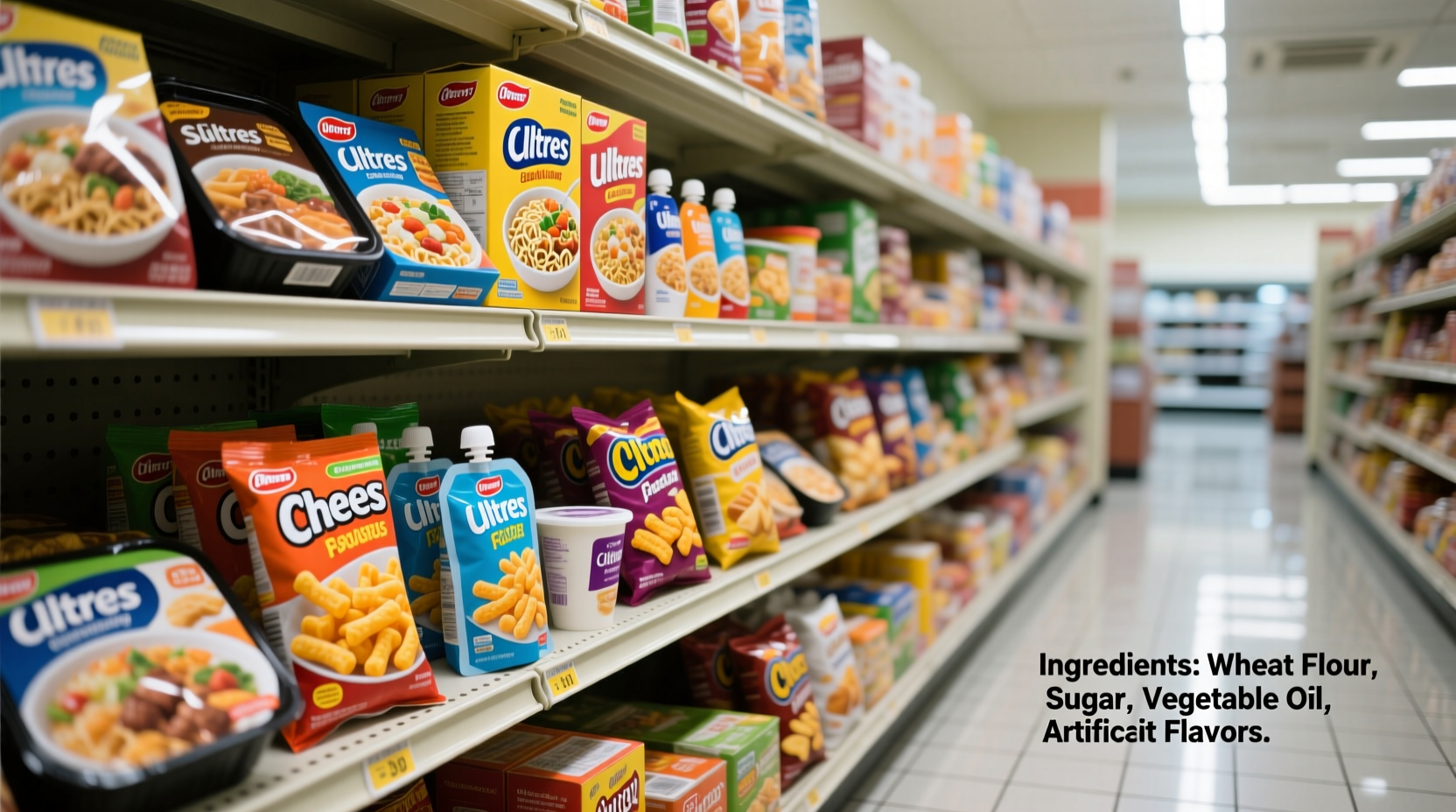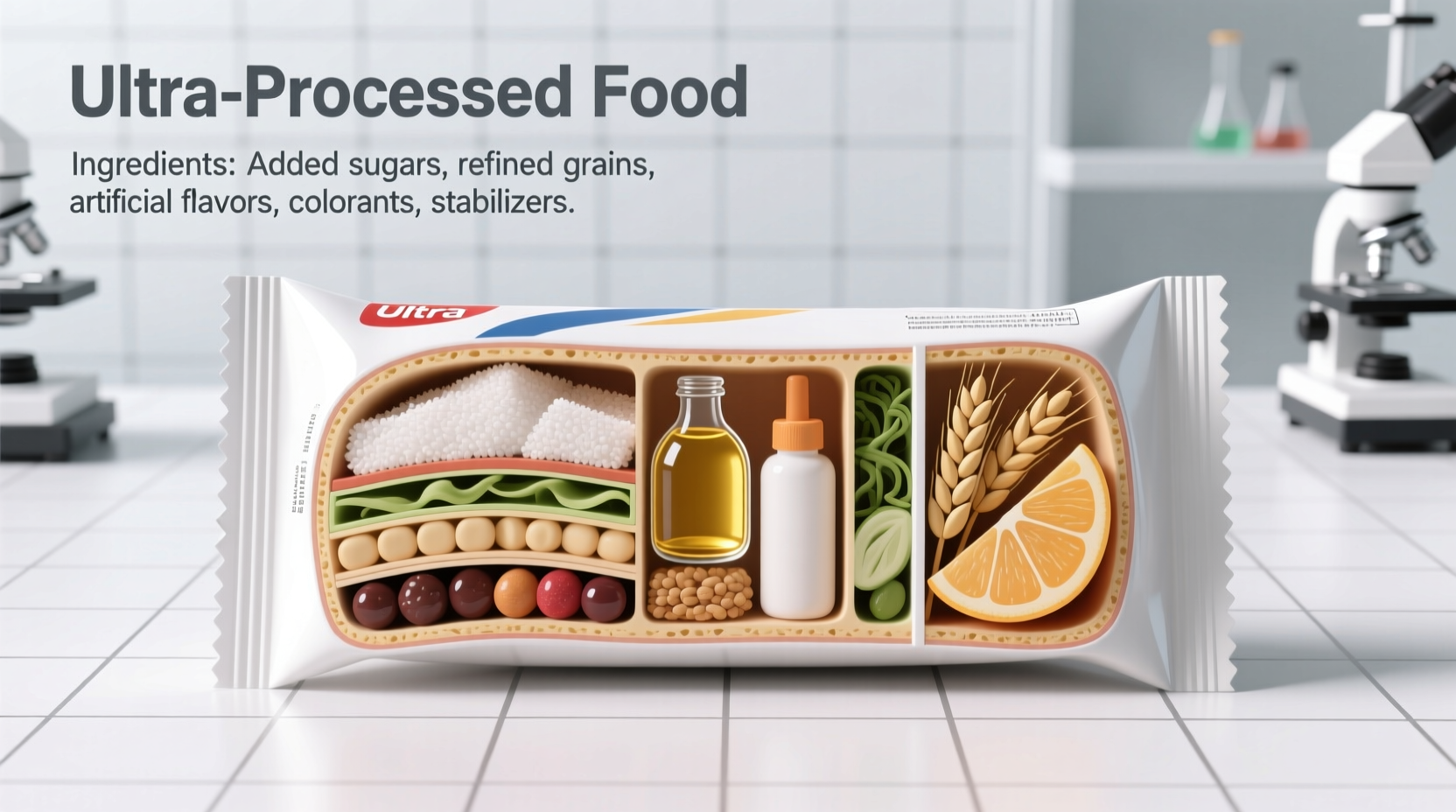Understanding what qualifies as an ultra-processed food helps you make informed dietary choices that support long-term health. This comprehensive guide explains the scientific definition, provides recognizable examples from your grocery store shelves, examines the health research, and gives practical strategies for identifying and reducing these products in your daily eating pattern.
Defining Ultra-Processed Foods: The NOVA Classification System
The most widely accepted framework for categorizing food processing comes from the NOVA system developed by researchers at the University of São Paulo. This system classifies foods into four groups based on the extent and purpose of processing:
| NOVA Group | Processing Level | Key Characteristics | Common Examples |
|---|---|---|---|
| Group 1 | Unprocessed or minimally processed | Natural foods with no added substances | Fresh fruits, vegetables, eggs, milk, rice, beans |
| Group 2 | Processed culinary ingredients | Substances extracted from Group 1 foods | Salt, sugar, honey, olive oil, butter |
| Group 3 | Processed foods | Group 1 foods combined with Group 2 ingredients | Canned vegetables, cheese, freshly baked bread |
| Group 4 | Ultra-processed foods | Industrial formulations with multiple additives | Soft drinks, packaged snacks, instant noodles, ready meals |
Ultra-processed foods (Group 4) undergo multiple industrial processes and contain ingredients rarely used in home cooking. These products are designed for convenience, long shelf life, and hyper-palatability through combinations of sugar, fat, and salt that override natural satiety signals.
Everyday Examples of Ultra-Processed Foods
These products surround us in modern food environments. Common ultra-processed food categories include:
- Sweetened beverages - Sodas, energy drinks, flavored coffees
- Industrial breads and buns - Most supermarket sandwich breads with long ingredient lists
- Sweet snacks and desserts - Packaged cakes, cookies, ice cream bars
- Savory snacks - Potato chips, cheese puffs, pretzels
- Ready-to-heat meals - Frozen pizzas, microwave dinners
- Breakfast cereals - Most sugary cereals marketed to children
- Processed meats - Hot dogs, sausages, chicken nuggets
What distinguishes these from regular processed foods? Ultra-processed items typically contain ingredients you wouldn't find in a home kitchen, like maltodextrin, sodium benzoate, or xanthan gum. They're engineered for maximum consumption through optimized texture, flavor, and appearance.

Health Implications: What Research Reveals
Multiple large-scale studies have examined the health impacts of ultra-processed food consumption. A landmark 2019 study published in The BMJ followed over 100,000 adults for five years and found that a 10% increase in ultra-processed food consumption correlated with a 12% higher risk of cardiovascular disease. Researchers from the University of São Paulo have documented similar patterns across multiple health outcomes.
Why might these foods negatively impact health? Several mechanisms appear involved:
- Nutrient displacement - They often replace more nutritious whole foods in the diet
- Additive effects - Some emulsifiers and artificial sweeteners may disrupt gut microbiota
- Overconsumption - Engineered for hyper-palatability leading to excessive calorie intake
- Nutrient quality - Typically high in added sugars, unhealthy fats, and sodium while low in fiber
The World Health Organization has noted that countries with higher ultra-processed food consumption generally show increased rates of obesity and related non-communicable diseases. This pattern holds even when controlling for socioeconomic factors.
How to Identify Ultra-Processed Foods in Your Diet
Spotting ultra-processed foods requires attention to packaging and ingredient lists. Here's what to look for:
- Check ingredient count - Products with more than five ingredients often qualify
- Look for unfamiliar substances - Ingredients like carrageenan, maltodextrin, or sodium nitrite
- Examine marketing claims - "Ready in 5 minutes," "microwaveable," "long shelf life"
- Consider food form - Does this resemble how the food appears in nature? (e.g., chicken nuggets vs. whole chicken)
- Read nutrition labels - High levels of added sugars, sodium, or saturated fats
When reading ingredient lists, remember that items are listed by quantity. If sugar (under any name) appears in the first three ingredients, the product likely qualifies as ultra-processed. Similarly, multiple forms of fat or multiple sweeteners indicate significant industrial processing.
Practical Strategies for Reducing Ultra-Processed Foods
Complete elimination isn't necessary or realistic for most people. Instead, focus on gradual reduction through these evidence-based approaches:
- Start with swaps - Replace sugary cereals with oatmeal, soda with sparkling water
- Plan simple meals - Focus on recipes with 5-7 whole food ingredients
- Read labels consistently - Make ingredient scrutiny part of your shopping routine
- Cook in batches - Prepare larger quantities of minimally processed meals for busy days
- Embrace traditional cooking - Learn basic techniques for preparing whole foods
Research shows that replacing just 10% of ultra-processed foods with unprocessed or minimally processed alternatives can yield measurable health benefits. Focus on progress rather than perfection—small changes accumulate significant health advantages over time.
Understanding Processing Context: Not All Processed Foods Are Equal
It's crucial to distinguish between different processing levels. Not all processed foods qualify as ultra-processed. Traditional processing methods like fermentation, freezing, or pasteurization can preserve nutrients and enhance food safety without creating health concerns.
Yogurt made from milk, cultures, and perhaps fruit represents processed food (Group 3), while fruit-flavored yogurt with high-fructose corn syrup, artificial colors, and stabilizers qualifies as ultra-processed (Group 4). The distinction lies in ingredient complexity and industrial formulation versus simple preparation.
This nuanced understanding prevents unnecessary food fear while empowering informed choices about which processed products align with health goals.
Frequently Asked Questions
What's the difference between processed and ultra-processed foods?
Processed foods typically contain two or three ingredients and undergo basic preparation like cooking or fermentation (canned beans, cheese, fresh bread). Ultra-processed foods contain five or more ingredients including additives not used in home cooking, and undergo multiple industrial processes that fundamentally alter the food structure.
Are all packaged foods considered ultra-processed?
No. Many packaged foods like frozen vegetables, canned beans without additives, or plain yogurt in containers are minimally processed. The key factor is ingredient complexity and processing methods, not packaging itself.
Can ultra-processed foods be part of a healthy diet?
In moderation, yes. Complete elimination isn't necessary for most people. The concern arises when ultra-processed foods dominate the diet, typically displacing more nutritious whole foods. Most health experts recommend keeping them below 20% of total daily calories.
How quickly do health improvements occur after reducing ultra-processed foods?
Some benefits like improved digestion and stabilized energy levels may appear within days. Longer-term benefits including weight management and reduced inflammation typically develop over weeks to months of consistent dietary changes. Research shows measurable metabolic improvements within two weeks of reducing ultra-processed food intake.











 浙公网安备
33010002000092号
浙公网安备
33010002000092号 浙B2-20120091-4
浙B2-20120091-4